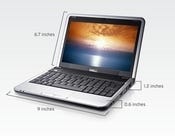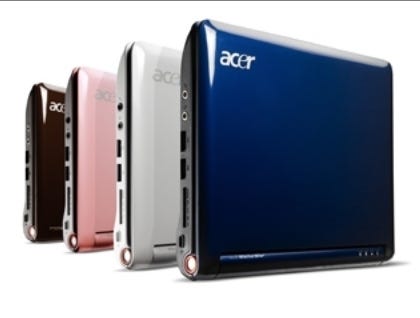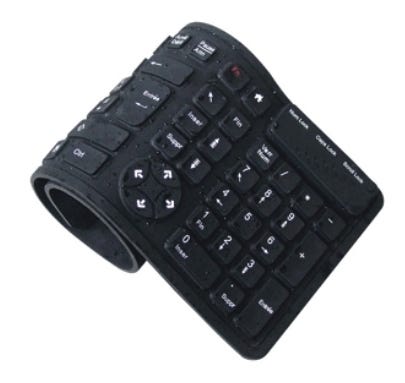These laptop replacements from Asus, Acer, Dell, MSI, and Sony are budget-friendly and road-ready. Bonus: We've rounded up some gear to enhance their basic mobile functions.

| |
| |
Netbooks are hot sellers. For years we've been charged exorbitant amounts of money for laptops with far less computing power than similarly priced desktop computers, so the idea that you can pay less for something that does less -- especially in the currently less than stellar economy -- has put the spotlight on netbooks.
There's also the novelty factor. We in computing just love new and different things. That may explain why new editions of netbooks seem to show up faster than baby bunnies at a rabbit farm.
But netbook reality can bite. Netbook keyboards are typically cramped to the point of actual discomfort after prolonged use. They would seem to be ideal for the spindly fingers of E.T. but lacking in comfort for the average ham-fisted human being.
Their screens are small -- often in the 8-to-11-inch size that prompts continual squinting at the tiny characters on the display panel. They have a reputation for using slow processors, small amounts of memory, and just enough hard disk space to be usable but not necessarily useful.
But from way out in left field there's a new generation of netbooks about to poke their small screens into your life. They have upgraded CPUs that are clocked slightly faster than their predecessors, more memory, and hard drives with larger capacities. Best of all, low-power operation and better battery tech have given rise to run times between 9 and 10 hours for some -- or so the claims go.
As we continue to replace desktop computers with portables, that $1,000+ you sunk into your baby (and much more if it's a gaming portable) is at risk if it's damaged or destroyed while traveling. (Let's not even mention how heavy they are.) A netbook, on the other hand, is practically a disposable item -- even in this economy.
You can get one scratched up, dropped, stolen, or lost and be out of pocket by only a fraction of the amount your "home portable" would cost to replace or repair. And because they typically weigh in around four pounds, at most, you can stuff one in your bag or briefcase and not end up with a backache at the end of the day.
| |
| |
Let's agree that the One Laptop Per Child's XO and the $20 netbook that the Vellore Institute of Technology in India is said to be introducing are honest endeavors meant for basic educational functions in underserved schools scattered across the globe. While the devices work within the context in which they were envisioned, outside of that arena they're practically little more than curiosities.
If we can agree to that, we're off to a running start. Although there seems to be a new netbook popping up almost weekly, we've selected samples from Asus, Acer, Dell, MSI, and Sony because they span the genre.
Asus Eee 1000HE
Asus is the netbook Prometheus. At least it's the company everyone points to as the culprit for starting the craze. The latest Asus Eee is the 1000HE. It features a "Super Hybrid Battery" engine that, according to Asus, will let you surf the 'Net for up to 9.5 hours -- while only weighing a miniscule 3.2 pounds.
The 10-inch screen offers 1024 x 600 resolution. It uses Intel's latest Atom N280 CPU and that's the star of this PC. The processor speed is bumped up a hair to 1.66 GHz from the older N270's 1.6 GHz, but the system's frontside bus has been raised a tad also, to 667 MHz.
The Eee 1000HE is pretty much a mundane netbook beyond that: It has 1 GB of RAM, a 160-GB hard drive, offers Bluetooth and 802.11n connectivity, and, most importantly, the keyboard has been redesigned to actually be usable -- it's about 92% of full size, or so the claim goes. That's not going to keep you from feeling a few finger cramps, but it should significantly cut down on them.
So what's the father of all netbooks going to set you back? Asus would like you to pay $400 (well, $399.99) but it's been seen for 5% to 8% below that amount if you look around a bit online. By all accounts, if the 1000HE isn't the notebook you buy, it should at least be the one you look at first so you have a basis for comparison.
Acer Aspire One
Dating all of the way back to July 2008, Acer's Aspire One is the old man in the sea of netbooks. Still, according to Displaybank, Acer sold more netbooks last year than anyone else, and has a significant lead on everyone so far this year (short as it's been until now).
| |
| |
What makes the Aspire One so special? Well, you can order it in your choice of seashell white, coral pink, sapphire blue, or golden brown. Beyond that, it's pretty much your run of the mill tiny tote: Intel Atom N270 CPU (1.6 GHz); 512 MB of memory (can you say Linux?) upgradeable to 1.5 GB; 8.9-inch 1024 x 600 LCD display; either an 8-GB Flash module or 120-GB hard drive installed; 802.11b/g; and an integrated 10/100 LAN port.
The Aspire One is sized at 9.8 x 6.7 x 1.14 inches and barely tips the scales at 2.19 pounds, if you've stayed with the 3-cell battery pack and 8-GB Flash drive, or 2.78 pounds if you've gone upscale with the 6-cell pack and 120-GB hard drive. By all accounts it has a reasonable keyboard and while the 0.3-megapixel integrated Webcam is really nothing to write home about, at least it has one.
If that sounds too minimalist, the Aspire One is blessed with two memory card slots. One does the usual plug-in cards from your camera or other digital device, while the second is used as an external storage drive for the netbook itself. Now your eyebrows are raised, aren't they?
The real attention grabber, however, is that while the MSRP on the Aspire One hovers around $400 (which is netbook territory), varying models of Acer's little bitty pretty one can be scooped up for as little as $250 online. You will get what you pay for, but that's not much of an investment if you're looking to dip your toe into the netbook waters.
| |
| |
Dell Inspiron Mini 9
If Dell is involved in the venture, then this whole netbook thing must be legitimate, yes? All right, hype aside, the Mini 9, although very late to market, isn't such a bad deal at all. It's sort of old school with an Atom N270 1.6-GHz processor, 512 MB of DDR2 memory (yes, Linux), 4-GB of Flash storage, and an 8.9-inch, 1024 x 600 LCD display. Maybe because it didn't break any new ground, the Mini 9 can be yours for around $329 with a quick search online.
Dell will also sell you an upgraded Mini 9 with more memory and more storage and even Windows XP -- you'll just pay extra for it. And Dell also offers discounts (as low as $99) if you get the optional mobile broadband card and are willing to tie yourself to AT&T.
The basic unit sizes up at 9.1 x 6.8 x 1.25 inches (at its thickest -- the Mini 9 tapers down in the front to about 1.1 inches) and weighs a scant 2.3 pounds. Whether or not you'd want to try to fit it into a mailing envelope or not is your choice, but that does make the Mini 9 awfully small and light. Conceptually, at least, you really could mail it in.
By all accounts, the trackpad is good, the mouse buttons are reasonable, and the keyboard is useable in that funny way that netbook keyboards accomplish that feat. For most, however, the draw for the Mini 9 is the four letters that spell out the manufacturer's name -- which is "Dell" in this case, not "Acer." (That's neither good nor bad. It's whatever lets you achieve maximum mental comfort.)
MSI Wind U120
We know... You looked at the original Wind U100, called it Mariah, and then went running and screaming into the halls. We did too. It was just too cute and cheap and neither of them in a good way. Things have changed. (All right, the internal speakers are, reportedly, just as bad as the original -- but that's about the only bad transplant.)
No, the Wind U120 is not the touch-screen version. That may show up with Windows 7, but for now you'll have to settle for a revised glide pad and dual mouse buttons. The internals remain the same as those found in the MSI U100 -- reportedly an Intel 1.6 GHz Atom processor, 1 GB of RAM, and a 160-GB hard drive. It sports a six-cell battery good for about 4.5 hours on a charge, is sized at 10.2 x 7.1 x 1.3 inches, and tips the scales at 2.8 pounds. (Add about another half pound if you're toting the charger.)
The keyboard is the same as well, but the U100 had a good keyboard, so keeping it was a reasonable choice. You'll be looking at a 10.2-inch LCD display at 1024 x 600 and a 1.3-megapixel Webcam will be looking back at you. A 4-in-1 card reader, 802.11g/n networking, three external USB ports, and headphone and mic jacks round out the connectivity for the $379 U120.
| |
| |
Sony Vaio P
Sony doesn't want you to call its Vaio P a "netbook." Even if it does weigh 1.4 pounds (with the standard battery); even if it only measures 9.65" x 0.78" x 4.72"; even if it has an 8-inch LED back-lighted 1600 x 768 display.
With pricing that starts at $900, it might be best not to think of it as a netbook technically, but it does pass every other smell test.
While it runs Windows Vista Home Premium, Sony employs a mere 1.33-GHz Intel CPU to get things moving. The 2 GB of DDR2 SRAM gives it enough memory for its initial running room and a 60-GB hard drive lengthens the track a bit. (If you have a gob of extra money you can equip it with a 128-GB solid state drive.)
Mobile broadband, 802.11g/n, and Bluetooth give it a good range of connectivity options. The Vaio P also has SD and memory stick duo slots, a spare USB port, and the optional upscale battery will keep it going for a claimed 8 hours. That's twice the rating of the standard battery pack and, of course, both times depend on what you're doing.
It might be difficult to wrap your mind around a netbook priced similarly to your current notebook or even less more that desktop PC you picked up at Costco. Still, you need to maintain perspective. There are folks who are more than willing to shell out $5,000+ on a gaming PC and that makes $900 for a netbook just a drop in the bucket. Then again, Sony doesn't want you to call the Vaio P a "netbook."
Gear To Go Along
No matter what type of computer you own, you probably have an assortment of gear to go along with it: thumb drives, USB hubs, USB-powered fans and Nerf missile launching systems, card readers, and the like just seem to appear of their own volition. As small a part of your life as netbooks might be, they too have their own entourage.
All of those are just a few of the possibilities. In fact, because they have reduced computing capabilities, you can subject netbooks to a lot more whimsy when it comes to these tag-alongs. Here's a sampling.
Keyboards
One of the biggest complaints about netbooks is the keyboard. Tiny and cramped to fit their form factor, they're just no fun to use for any length of time. How about we change that? Naturally, if you're carrying around a 10-inch netbook, a 16-inch keyboard is out of the question. What about a flexible keyboard?
Hela's Duraflex Keyboard is one possible option. It's resistant to dirt, food, alcohol, most cleaning products, and, according to the manufacturer, even coffee or tea. The rubberized keyboard folds up into a big egg roll and you can find it online for around $45.
Tripp Lite (yes, the UPS people) has several flexible alternatives and the wildest of them is appropriately called the Wireless Flexible Multimedia Keyboard. It has an $80 suggested retail price but the freedom from cabling is probably worth the price of admission.
| |
| |
Drives
There are the obvious external storage options for netbooks. They include Western Digital's Elements series or the LaCie Little Disk, among a larger array of possibilities.
But you might consider something a little more dramatic, like the Seagate FreeAgent Theater. It's a combination of a FreeAgent drive and a docking station that will let you display images, movies, or music from the drive onto your home theater. It's not out yet, so pricing is not available but it should be showing up any time now.
On the far side of the moon, Ridata should be releasing a combo drive in March that is a bit more than your average hard drive. There's practically no information available right now, but it is a 32-GB SSD that has both USB and eSATA connectivity so you can transfer your data between your netbook and your desktop system with renewed vigor.
Power
Sure you could schlep around your netbook's power supply, but why? You may already be carrying power supplies for your cell phone and any number of other gadgets. IGo might have a solution for you with its everywhereMax Notebook Adapter. At less than 1 pound and about $140, iGo says it will charge your netbook "plus a mobile electronic device."
Digital Projector
If you've gone upscale with netbook, perhaps with Sony's Vaio P or an upgraded base model that gives you enough memory to do more than surf the Internet, you might consider 3M's Mpro110 Micro Digital Projector. It'll fit in the palm of your hand, weighs just over 5 ounces, and can project up to a 60-inch diagonal image (at 1280 x 768).
It's a bit extravagant at just under $400 online, but if you're a businessperson with PowerPoint slides floating around on your hard drive, a good netbook and the Mpro110 sure beats lugging around full-sized gear.
Wi-Fi Finders
Last and certainly not least are Wi-Fi finders. Why? Because even though popping open your netbook and letting it scan for an available hotspot might seem like no big deal, about the 12th or 15th time you do it, things will start to get old and boring.
A Wi-Fi detector like Kensington's Wi-Fi Finder Plus tends to filter out false positives from cell phones, garage door openers, and microwave ovens, giving you a clear reading of honest 802.11b/g hot spots.
If you have an extra $50 hanging around, Canary's Digital Hotspotter has been upgraded to also find 802.11n hotspots for faster communications.
InformationWeek will host a webcast, Six Ways To Cut Laptop And Mobility Costs on Feb. 18. The focus will be on how IT and networking groups with fixed budgets can meet the demands of a growing mobile workforce. For more information, click here. (Registration required.)
For Further Reading:
Ultra Mobile PC Buyer's Guide
How To Buy A Laptop
Laptops For Less: 25 Notebooks Under $600.
About the Author(s)
You May Also Like














